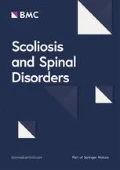Background
Orthotic treatment of children with AIS is a generally accepted treatment option. Failure of bracing to halt curve progression has been reported in 20% or more of patients, and it is known that some curves in children with AIS will not progress even if untreated. Success and failure rates of brace treatment vary considerably.
Purpose
We reviewed the response to brace treatment in patients who were also analyzed with a DNA-based adolescent idiopathic scoliosis progression test (AIS-PT) and compared this with the natural history of adolescent idiopathic scoliosis without treatment. Our purpose was to document the influence of orthotic care on the outcome at skeletal maturity.
Methods
Medical records and x-rays were reviewed, and DNA was collected with a saliva sample in two cohorts of Caucasian female AIS patients. A risk of progression score was calculated using 53 genetic markers with utility for calculating the risk of AIS curve progression from < 25° to > 40° before skeletal maturity or > 50° at maturity (1-200). Group A (2442 females) had no brace treatment and their outcome at maturity or surgery was known. Group B (308 females) were brace compliant for more than one year and their curve severity at maturity or surgery was known.
Results
There was little statistical difference in the curves representing risk of progression versus curve severity when the two groups were compared. (Figure 1)

Figure 1
Conclusion
In this retrospective study of US Caucasian females, there was no statistically significant difference in the natural history of adolescent idiopathic scoliosis when comparing bracing treatment and no bracing treatment. At best, there was only a modest brace effect. Prospective trials with genotype homogeneity are needed to validate current assumptions about the efficacy of orthotic types and treatment regimens when bracing adolescent idiopathic scoliosis.
Author information
Authors and Affiliations
Corresponding author
Rights and permissions
Open Access This article is published under license to BioMed Central Ltd. This is an Open Access article is distributed under the terms of the Creative Commons Attribution 2.0 International License (https://creativecommons.org/licenses/by/2.0), which permits unrestricted use, distribution, and reproduction in any medium, provided the original work is properly cited.
About this article
Cite this article
Ogilvie, J., Nelson, L., Chettier, R. et al. Does bracing alter the natural history of Adolescent Idiopathic Scoliosis?. Scoliosis 4 (Suppl 2), O59 (2009). https://doi.org/10.1186/1748-7161-4-S2-O59
Published:
DOI: https://doi.org/10.1186/1748-7161-4-S2-O59

